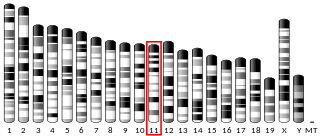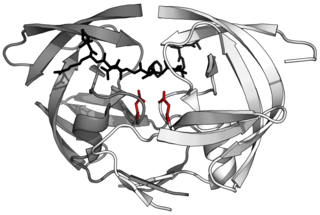Related Research Articles

Papain, also known as papaya proteinase I, is a cysteine protease enzyme present in papaya and mountain papaya. It is the namesake member of the papain-like protease family.

A disintegrin and metalloproteinase with thrombospondin motifs 2 (ADAM-TS2) also known as procollagen I N-proteinase is an enzyme that in humans is encoded by the ADAMTS2 gene.

Bone morphogenetic protein 1, also known as BMP1, is a protein which in humans is encoded by the BMP1 gene. There are seven isoforms of the protein created by alternate splicing.

Aspartic proteases are a catalytic type of protease enzymes that use an activated water molecule bound to one or more aspartate residues for catalysis of their peptide substrates. In general, they have two highly conserved aspartates in the active site and are optimally active at acidic pH. Nearly all known aspartyl proteases are inhibited by pepstatin.
Procollagen peptidase is an endopeptidase involved in the processing of collagen. The proteases removes the terminal peptides of the procollagen. Deficiency of these enzymes leads to dermatosparaxis or Ehlers–Danlos syndrome.
Kexin is a prohormone-processing protease, specifically a yeast serine peptidase, found in the budding yeast. It catalyzes the cleavage of -Lys-Arg- and -Arg-Arg- bonds to process yeast alpha-factor pheromone and killer toxin precursors. The human homolog is PCSK4. It is a family of subtilisin-like peptidases. Even though there are a few prokaryote kexin-like peptidases, all kexins are eukaryotes. The enzyme is encoded by the yeast gene KEX2, and usually referred to in the scientific community as Kex2p. It shares structural similarities with the bacterial protease subtilisin. The first mammalian homologue of this protein to be identified was furin. In the mammal, kexin-like peptidases function in creating and regulating many differing proproteins.

Tripeptidyl-peptidase 1, also known as Lysosomal pepstatin-insensitive protease, is an enzyme that in humans is encoded by the TPP1 gene. TPP1 should not be confused with the TPP1 shelterin protein which protects telomeres and is encoded by the ACD gene. Mutations in the TPP1 gene leads to late infantile neuronal ceroid lipofuscinosis.

Procollagen C-endopeptidase enhancer 1 is an enzyme that in humans is encoded by the PCOLCE gene.

Dipeptidyl peptidase I is an enzyme. This enzyme catalyses the following chemical reaction
Cathepsin X is an enzyme. This enzyme catalyses the following chemical reaction
Nepenthesin is an aspartic protease of plant origin that has so far been identified in the pitcher secretions of Nepenthes and in the leaves of Drosera peltata. It is similar to pepsin, but differs in that it also cleaves on either side of Asp residues and at Lys┼Arg. While more pH and temperature stable than porcine pepsin A, it is considerably less stable in urea or guanidine hydrochloride. It is the only known protein with such a stability profile.
Gamma-D-glutamyl-meso-diaminopimelate peptidase is an enzyme. This enzyme catalyses the following chemical reaction
Lysyl endopeptidase is an enzyme. This enzyme catalyses the following chemical reaction
Pancreatic endopeptidase E is an enzyme. This enzyme catalyses the following chemical reaction
Glutamyl endopeptidase II is an enzyme. This enzyme catalyses the following chemical reaction
Signal peptidase I is an enzyme. This enzyme catalyses the following chemical reaction
Glycyl endopeptidase is an enzyme. This enzyme catalyses the following chemical reaction
Caricain is an enzyme. This enzyme catalyses the following chemical reaction: Hydrolysis of proteins with broad specificity for peptide bonds, similar to those of papain and chymopapain

Scytalidocarboxyl peptidase B, also known as Scytalidoglutamic peptidase and Scytalidopepsin B is a proteolytic enzyme. It was previously thought to be an aspartic protease, but determination of its molecular structure showed it to belong a novel group of proteases, glutamic protease.

The sedolisin family of peptidases are a family of serine proteases structurally related to the subtilisin (S8) family. Well-known members of this family include sedolisin ("pseudomonalisin") found in Pseudomonas bacteria, xanthomonalisin ("sedolisin-B"), physarolisin as well as animal tripeptidyl peptidase I. It is also known as sedolysin or serine-carboxyl peptidase. This group of enzymes contains a variation on the catalytic triad: unlike S8 which uses Ser-His-Asp, this group runs on Ser-Glu-Asp, with an additional acidic residue Asp in the oxyanion hole.
References
- ↑ Hojima Y, van der Rest M, Prockop DJ (December 1985). "Type I procollagen carboxyl-terminal proteinase from chick embryo tendons. Purification and characterization". The Journal of Biological Chemistry. 260 (29): 15996–6003. PMID 3905801.
- ↑ Kessler E, Adar R (December 1989). "Type I procollagen C-proteinase from mouse fibroblasts. Purification and demonstration of a 55-kDa enhancer glycoprotein". European Journal of Biochemistry. 186 (1–2): 115–21. doi: 10.1111/j.1432-1033.1989.tb15184.x . PMID 2689170.